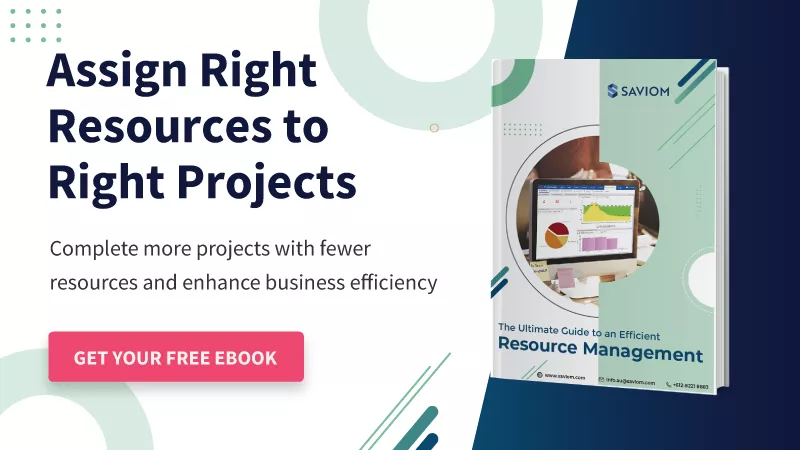In an ever-changing business landscape, do you often find it challenging to predict the future resource demand? Or do you constantly wonder how you will future-ready your workforce to deal with market volatility?
Efficient Resource Capacity Planning is the most practical solution to address these concerns. It takes both current and pipeline project demand into account to ensure you have the right resources with matching skillsets available and there are no hiccups along the way.
Capacity planning helps bridge the skills gap, allowing you to effectively utilize the resources and complete the projects on time and within budget.
However, managers often face bottlenecks at the capacity planning stage, which, of course, is their worst nightmare. On the one hand, having insufficient capacity results in delayed timelines, dissatisfied clients, and overscheduled resources dealing with a massive workload.
On the other hand, having excess capacity means that you are not utilizing your resources to their full extent, affecting the bottom line. This is why managers should address these bottlenecks sooner than later to secure the project’s fate.
 In this article, you’ll learn some fundamental ways to manage capacity planning bottlenecks and ensure project success. But first, let’s begin by understanding how to spot them:
In this article, you’ll learn some fundamental ways to manage capacity planning bottlenecks and ensure project success. But first, let’s begin by understanding how to spot them:
Signs of capacity planning bottlenecks
The quickest way to identify a bottleneck is to look at your company’s workload and ascertain whether projects are being executed smoothly or delivery managers are firefighting for resources. It is a no-brainer that the latter is symptomatic of a severe problem.
Below is a list of some prominent telltale signs of capacity planning bottlenecks:
Skills mismatch
In a multi-project environment, if you observe there is a constant mismatch in the skillsets available with respect to project requirements, incompetent resources are given high-level tasks, or a wrong candidate is recruited, then they indicate a pitfall in the resource planning. When these signs surface consistently, it’s an indication for managers to revisit the capacity planning process.
Excess/shortage of resources
As the available capacity is less than the demand or the available resources don’t have the requisite skillset, project vacancies remain unfulfilled. It implies that there is a shortfall of resources. In another case, there is an unusual increase in bench size and time, indicating underutilization of resources or wrongful hiring. These signs indicate a gap in the capacity planning process. As a result, businesses might lose market opportunities, billing loss and find it hard to sustain amid the market volatilities.
Read More: What is Resource Capacity Planning? An Ultimate Guide for Every Project Manager
Unavailability of niche resource
Suppose there is a project that will begin shortly, but you see the unavailability of niche resources at the eleventh hour. This leads to a delay in the project, and managers may even assign under-skilled resources on critical work, which causes schedule overruns affecting the quality of delivery. Thus, the constant absence of a highly skilled or critical resource is a major sign of a capacity planning bottleneck.
A surge in employee attrition/absence
If the employee absences and turnover rates for a business are growing at an alarming rate, it can take a toll on the bottom line. This can happen when resources are underutilized, not assigned to projects matching their skills and capability, or overloaded with work against their capacity. If these occur frequently, the resources will disengage and eventually find opportunities elsewhere. This can be one reason for the gap in the capacity planning process.
The rise in the hiring-firing cycle
If there is frequent hiring/firing in the organization and you witness that after hiring resources, they let go of these resources, and then hire similar resources for different projects. This means that there is no adequate resource planning process in the company. For instance, if there is a one-time project, but you hire a permanent resource. Then, after the project work finishes, the firm will struggle to find a suitable opportunity and have no option but to let go of the resource.

These signs of capacity planning bottlenecks can be faced head-on by simply implementing the right resource management software. Here’s how:
Effective ways to manage capacity planning bottlenecks
As stated earlier, failing to tackle various capacity planning bottlenecks well can hamper the project’s execution and delivery. Therefore, a resource manager needs to stay forewarned of the potential roadblocks and handle them beforehand.
Enterprise resource management software can help resource managers be proactive and forward plan pipeline projects effectively. Here’s a rundown of how the software is instrumental in combating capacity planning bottlenecks:
Use a centralized platform for enterprise-wide visibility
As mentioned before, skill mismatch is a huge challenge that can lead to other project bottlenecks such as compromised quality, delayed deadlines, etc. To avoid this, managers can implement a resource management solution that provides 360-degree visibility of all resources across the enterprise on a single platform, including their skills, qualification, experience, cost, etc.
In addition, it consolidates resource-related information such as their present and future schedules, availability, etc. Leave information helps managers to plan before the resource goes on vacation instead of leaving it for the last minute, which can cause a bottleneck due to resource dependency. Moreover, managers can view the future project demand in advance, which helps allocate the right resources with skills, experience, qualifications, and expertise to the right projects. This will eventually enable them to prevent any case of mismatched skillset and keep the projects on track.
Prioritize projects based on business strategy
Often, resources spend their maximum time on non-critical projects. This can affect the other priority projects because if their positions are not filled, it will delay the onset and lead to client dissatisfaction. Therefore, managers must carefully assess which projects are high and low priority through a systematic project prioritization framework.
This will help them understand which projects meet the immediate objectives, bring in more revenue, and add value to the business’s long-term goals. Accordingly, managers can fulfill the demand for the critical projects first and allocate the resources appropriately. It will allow you to take up profitable and strategically aligned projects first and ensure that your company’s resources are utilized at the right place.
Forecast future resource demand in advance
When the positions are not filled in advance, it will delay the project and result in billing loss. It may also lead to last-minute firefighting, escalated costs, subpar quality of deliverables, and so on. Therefore, managers should stay forewarned of the pipeline resource demand and plan effectively to combat any potential capacity planning bottleneck. Forecasting the demand provides enough lead time to conduct hiring and training activities for fulfilling any open position ahead of the curve.
Moreover, this foresight into capacity and demand for future projects helps resource managers to form the resource plan before the project begins, implement various resourcing treatments, and prevent future roadblocks.
Read More: How to Measure Resource Capacity and Demand
Formulate a plan to bridge the skill gap proactively
The evolving technology trends can play a significant role in enforcing the skill gap within the organization. It can result in the loss of many viable market opportunities as you don’t have an adequately skilled workforce to take up advanced projects and complete them successfully. Therefore, managers have to formulate a plan and take corrective action to bridge this skill gap proactively.
Depending on the nature of the skillset and the project duration, one can initiate retraining and upskilling programs for available employees or hire a permanent/contingent workforce with the right skillset. In addition, foresight into pipeline projects will give sufficient lead time to build a future-ready workforce. These practices enable you to reduce last-minute firefighting, futureproof the workforce, increase the firm’s sustainability, and help maintain a competitive edge.
Create an optimum combination of full-time vs. contingent resources
The rise of a hybrid workforce is gaining momentum within service organizations. Therefore, balancing the resource pool with a judicious mix of highly skilled permanent employees and contingent workers keeps work operations feasible. This helps you fill the short-term requests, reduce bench time and at the same time minimize resourcing costs. It also fosters innovation and assists in meeting ever-increasing client expectations.
For instance, let’s consider that there is a demand for a niche skillset in a project. So here, managers should analyze the project requirements and compare them with other pipeline projects. This will give them an idea if the requirement is recurring or limited to one project. Accordingly, they can hire a permanent resource or a contingent worker for a one-time project instead of a permanent one. This will eliminate the challenges of redeploying them to future assignments and resorting to unnecessary firing.
Implement advanced resource requisition
When managers have foresight into the pipeline demand, they can raise requests in advance giving enough time to procure the right project team. Depending on that, the resource manager starts capacity planning by analyzing the demand against existing capacity, thus leaving no room for unnecessary pitfalls. Sometimes, a project manager can also raise resource requests in a staggered manner due to evolving client requirements.
In this scenario, the onus is on the resource manager to fulfill these requests on time without hampering the project timeline. A resource management tool will help automate these requisition workflows and maintain an audit trail for better transparency.
Read More: 5 Easy Steps to Request Resources Efficiently
Ensure competent resource allocation
Having the right employee with the right skills and cost is crucial for a project to finish within budgeted time and cost. A resource manager first analyzes requests from project managers to identify and assign resources whose skill set is aligned with the demand. An effective resource management solution provides unmatched visibility into the resource attributes such as skills, location, experience, availability, utilization, etc. Thus, resource managers can drill down using advanced filters to identify the right candidate for the right opportunity.
Besides skills, managers also have to factor in various attributes like project budget, resource location, experience, etc. Even when you find the resources keeping their availability and utilization in mind is essential so as not to overutilize or overburden them. This will help eliminate capacity planning bottlenecks such as incompetent allocation or mismatched skillset, etc., and ensure successful project delivery within time and budget.
Consider scenario planning with modeling and simulation technique
Forming the right resource mix without hampering the ongoing project’s progress in a multi-project scenario is arduous. To simplify this, managers can create numerous scenarios using modeling and simulation techniques. It helps the managers gauge different ways they can allocate resources to various tasks, compare the possible outcomes and make data-driven decisions.
These changes can be simulated in a sandbox environment, and the best possible strategy can be applied to the actual resource plan. Accordingly, the resource manager can form different resource mixes to ensure a profitable project and maintain the resource health index.
Establish a contingency plan for resource-related risks
In coordination with the resource manager, the project manager plays a vital role in creating a resource risk management plan to avoid the derailment of projects. They stay abreast of issues and create a plan ahead of time to tackle them if they surface. These resource risks include a sudden increase in bench size, shortage of resources, unplanned absences, or unplanned attrition.
For example, if managers foresee any critical resource leaving the organization, they can conduct succession planning in advance to keep projects on track. In another scenario, prolonged absenteeism of a critical resource can hamper the project timeline and contribute significantly to project delays. Therefore, managers can develop a replacement/backup plan if this risk occurs. Thus, a practical resource risk management strategy is formulated to mitigate resource-related issues ahead of time.
Read More: How to Mitigate Resource Risk in Project Management?
This way, resource management can be a great value addition to combat the capacity planning bottlenecks by centralizing enterprise-wide resources and forming a resource strategy ahead of the curve.
Conclusion
Resource capacity management is the hallmark of organizational success and business sustainability. It helps ensure that the organization maintains a competitive edge in a constantly changing marketplace to meet the project demands.
By utilizing a comprehensive capacity planning tool, companies can understand various bottlenecks in advance, shore up any gaps, avoid potential pitfalls, and achieve more with fewer resources. The above-mentioned best practices will help improve your capacity planning process and futureproof the workforce.
The Glossary
Read More: Glossary of Resource Workforce Planning, Scheduling and Management
The SAVIOM Solution
SAVIOM is the market leader in offering the most powerful and configurable solutions for managing enterprise resources efficiently and effectively. Having more than 20 years of experience, this Australian-based MNC has a global presence in over 50 countries. It is also popular with more than 100 customers and helps them achieve their business goals. SAVIOM also has products for project portfolio management, professional service automation, and workforce planning software which can be easily customized as per business requirements.










